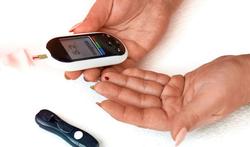Most early symptoms of diabetes are the result of a blood glucose level that is higher than normal. The warning signs can be so mild that you don't notice them. This is especially true with type 2 diabetes. In type 1, symptoms usually occur quickly, in a few days or a few weeks. They are also much more serious.
What symptoms may indicate diabetes?
Both types of diabetes have some of the same warning signs.
- Hunger and fatigue. Your body converts the food you eat into glucose that your cells use for energy. But your cells need insulin to absorb glucose. If your body doesn't make enough or no insulin, or if your cells resist the insulin your body makes, the glucose can't get into your cells and you don't have energy. This can make you hungrier and more tired than usual.
- Urinating more often and being more thirsty. The average person usually urinates between four and seven times in 24 hours, but people with diabetes urinate much more often. Normally, your body absorbs glucose again when it passes through your kidneys. However, if diabetes raises blood sugar levels, the kidneys are unable to absorb everything again. This causes the body to produce more urine, and that costs fluid. The result is that you have to urinate more. Because you pee so much, you can get more thirsty.
- Frequent urinary tract infections or fungal infections. Due to too much glucose in your blood, glucose can also enter your urine. Glucose in the urinary tract and genital area can lead to infections, such as urinary tract or fungal infections.
- Dry mouth and itchy skin. Because your body uses fluid to urinate, there is less fluid for other things. You may become dehydrated and your mouth may feel dry. Dry skin can start to itch.
- Blurred vision. The changing moisture content in your body can cause the lenses in your eyes to swell. They change shape and can no longer focus.
- Slowly healing wounds. This is the result of poor blood circulation, a reduced immune system and inflammation, which is typical of diabetes.
- Unexplained weight loss. Due to a lack of insulin in the body, glucose cannot get into the cells where it is used for energy. If glucose is not available as an energy source, the body uses fat and muscle for energy, which often leads to weight loss.
Can you reverse early symptoms?
Type 1 diabetes cannot be prevented or cured, but you can do something about type 2 diabetes by making adjustments to your lifestyle.
- Losing weight, even 5 to 7 percent of your body weight, can lower your risk of developing type 2 diabetes.
- When you're physically active, your insulin sensitivity increases and blood glucose levels improve. For this you need to exercise at least 150 minutes a week at a moderate intensity (e.g. walking).
- Make healthier food choices. Try eating less sugar and adding more vegetables to your diet. That can have a direct impact on blood glucose levels, reducing your risk of type 2 diabetes.
- Learn to deal with stress. For example, you can lower stress hormones, such as cortisol and adrenaline, which raise blood sugar levels.
Sources:
webmdcdc




